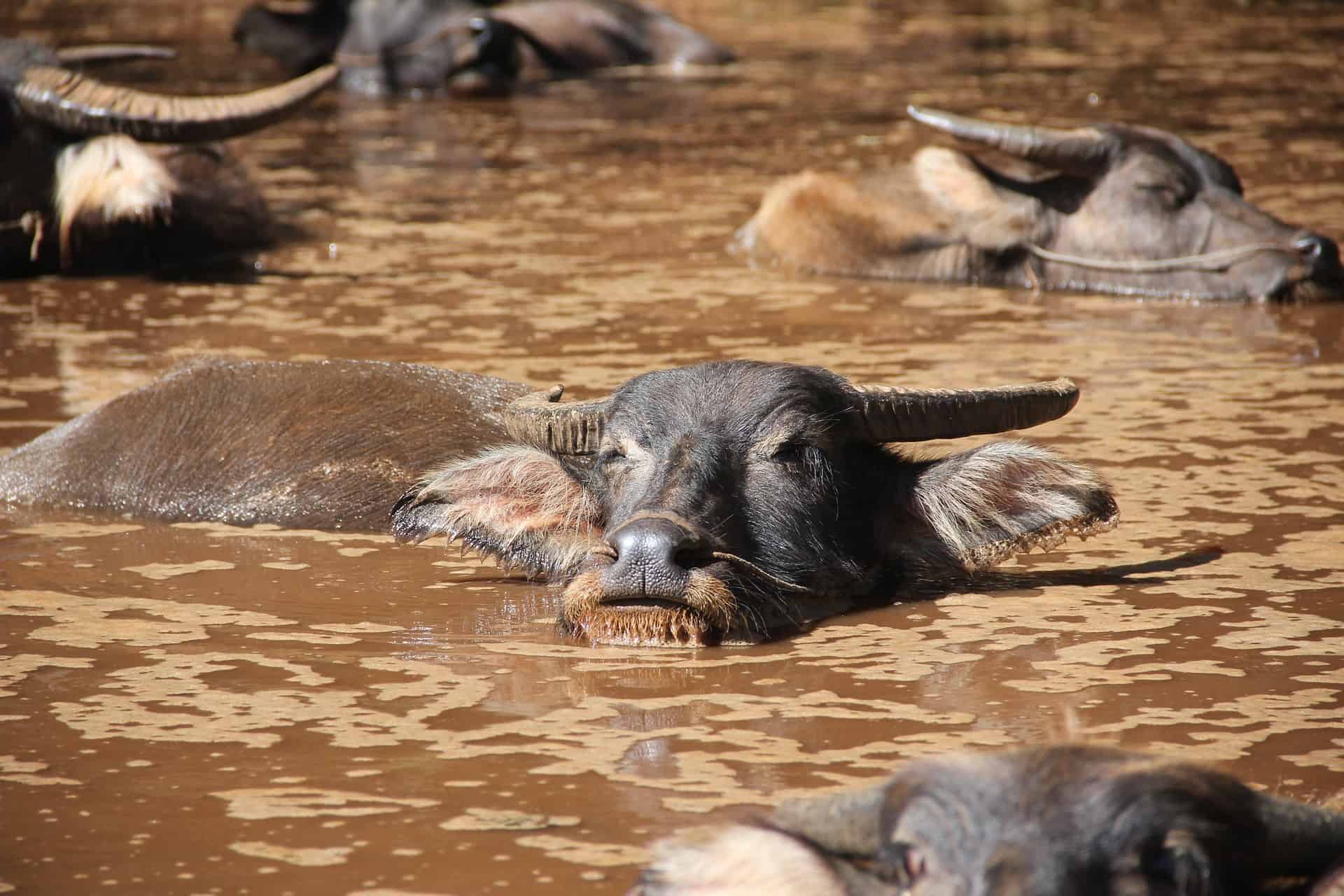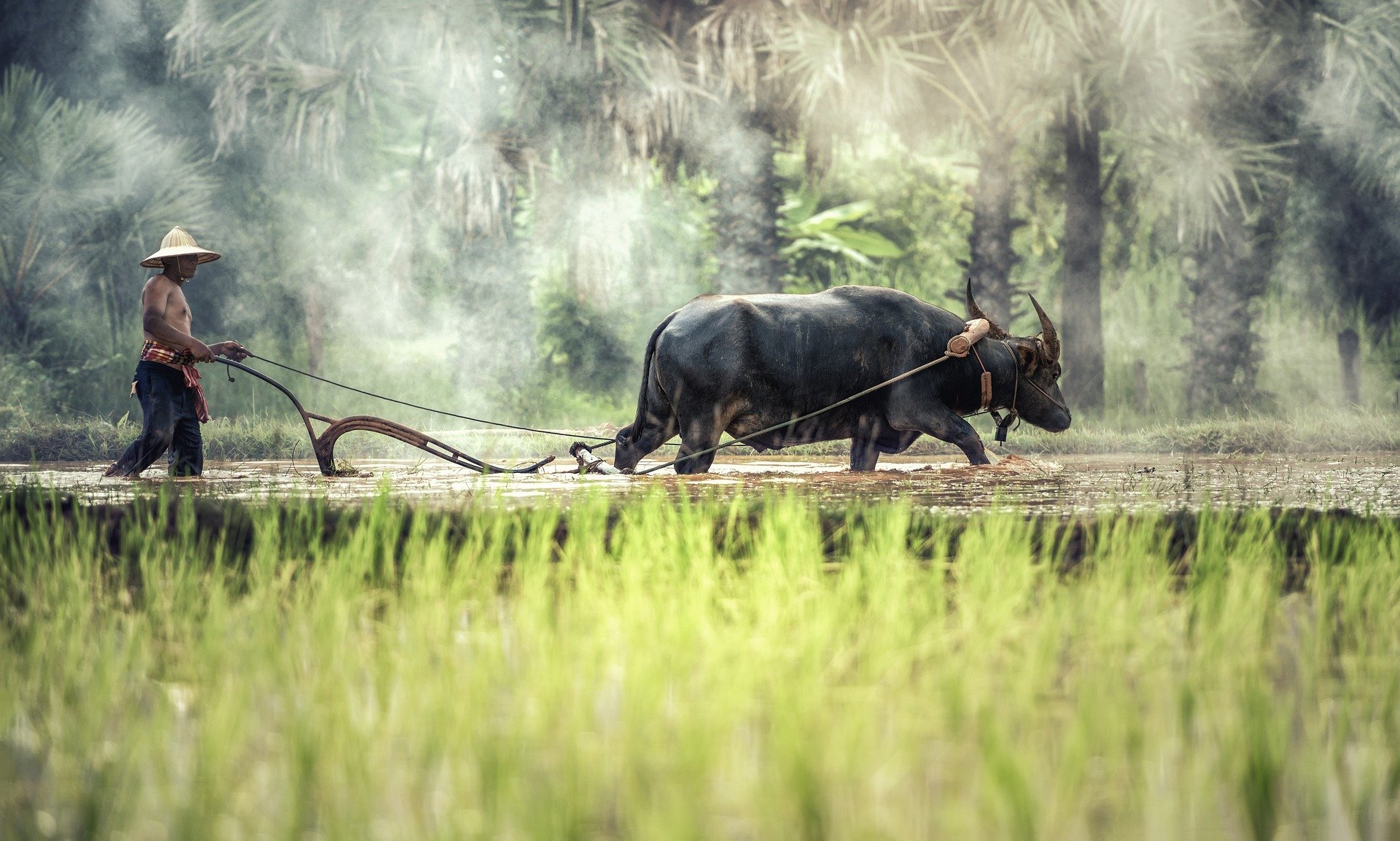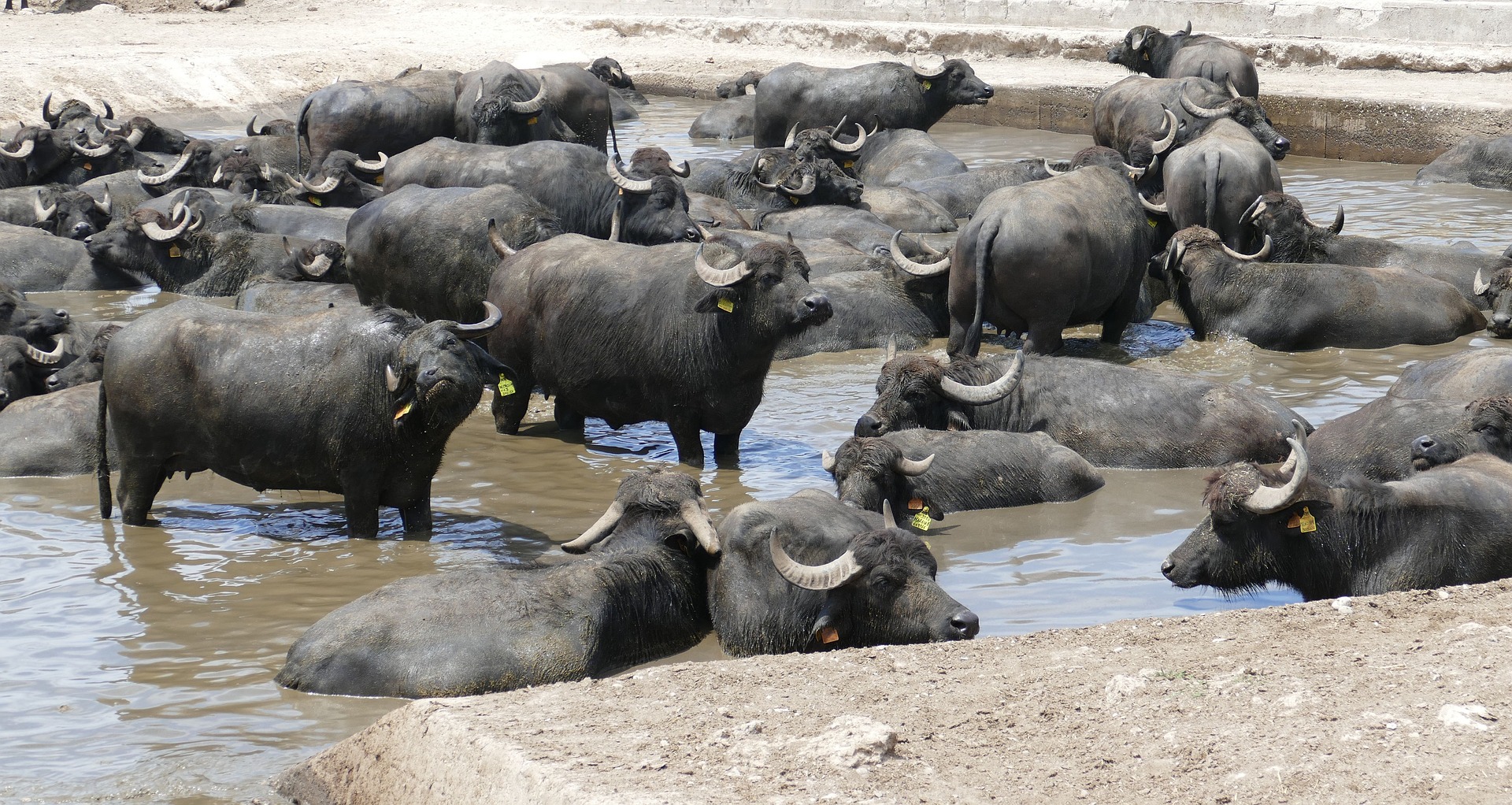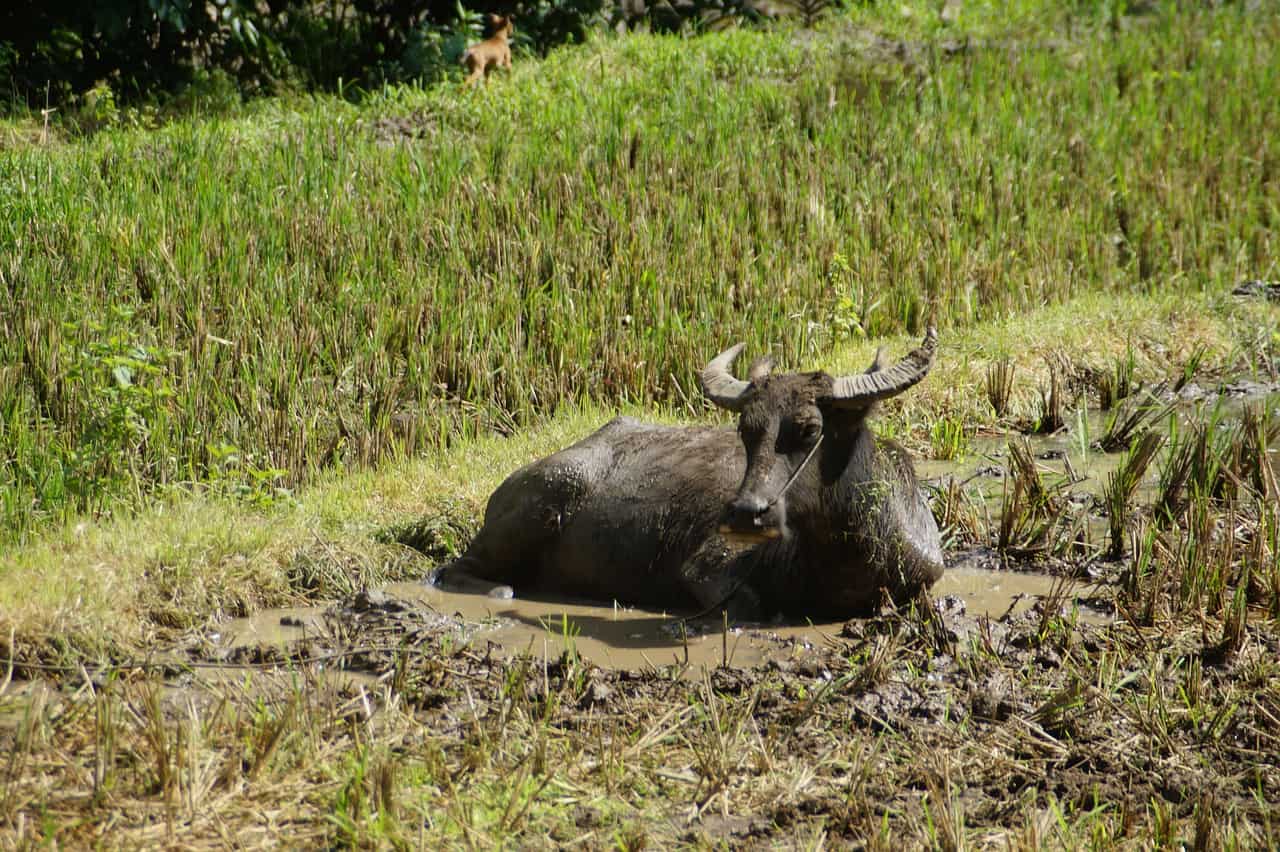
The water buffalo is a mammal famous for its strength and reliability. Domestic water buffaloes have been working tirelessly alongside humans for thousands of years. They now spread throughout many parts of the world due to their sheer usefulness in farms and other agricultural industries. Many even view these strong mammals as “living tractors”. There’s always more to learn about these interesting creatures. So read these powerful water buffalo facts to learn more about these awesome working animals.
- Carl Linnaeus first described the water buffalo in 1758.
- Male water buffaloes have an average height of 51 to 52 in (129 to 133 cm) at the shoulder. Females have an average height of around 47 to 50 in (120 to 127 cm).
- Larger water buffaloes can grow up to 63 in (160 cm) at the shoulder.
- Their weights range anywhere between 660 and 1,210 lb (300 to 550 kg).
- Their horns can reach 5 feet (1.5 m) in length. However, the longest recorded horn length measured just under 6.6 ft (2 m).
- Water buffaloes have large, crescent-shaped horns.
- A baby water buffalo is called a calf.
- Water buffaloes are herbivores or plant-eaters.
- They can be active in both daytime and nighttime.
- The males are often referred to as bulls, while the females are called cows.
- The scientific name of the water buffalo is Bubalus bubalis.
- Some may refer to them as the Asian water buffalo or domestic water buffalo.
- They belong to the family Bovidae, which includes African buffaloes, antelopes, domestic cows, sheep, goats, and muskoxen.
- The hairs on their body are sparse and long, typically black in color.
- To determine if a female water buffalo is willing to mate, the male has to sniff her urine and genitals.
- While water buffaloes typically live near bodies of freshwater, some breeds can tolerate living near saltwater shores.
- The water buffalo is the second animal in the Vietnamese zodiac, the third animal of the Thai zodiac, and the fourth animal in the Sinhalese zodiac.
- Water buffaloes symbolize a thoughtful life in Chinese tradition.
- Yama, the Hindu god of death, is often depicted as riding a water buffalo. The water buffalo also typically represents evil in Indian mythology.
- Some Indian cultures worship goddesses that rode on water buffaloes, such as Vihat and Varahi.
Water buffaloes wallow in water or mud to regulate their body temperatures.

The water buffalo gets its name from its tendency to spend most of its time wallowing in water or mud. Water buffaloes do this because they have very few sweat glands, similar to pigs. As a result, they are more sensitive to high temperatures than other bovines. They need to seek shade more often and cool themselves down by dipping themselves in mud holes or bodies of water. Water and mud also provide some protection against parasitic insects that may feed on their blood.
Sometimes, they may even submerge themselves almost completely underwater, only leaving their nostrils and eyes above the surface. They also may create mud holes using their horns. Water buffaloes also evolved wide-splayed hooves to help in walking through swamps and muddy grounds, as these wide hooves help prevent these large animals from sinking too deep in the mud.
There are two main types of water buffalo.
Despite having more than 70 breeds, only two main types of water buffaloes exist — the river-type and the swamp-type water buffaloes. The two types vary in many ways. River-type water buffaloes, as their name suggests, prefer to swim in deeper bodies of water, such as rivers. They’re mainly selected for their milk, and they have long faces and limbs compared to the swamp-type water buffaloes. Swamp-type water buffaloes, on the other hand, have larger and stockier bodies. Swamp buffaloes also take longer to mature than river buffaloes. They tend to wallow in more shallow mud holes rather than deep bodies of water.
The two types of water buffalo have different genes.
Aside from having notable differences in their appearances, habitats, and behaviors, river-type water buffaloes and swamp-type water buffaloes also differ significantly in their genetic makeup. Recent studies have shown that the two types split off from one another as early as 1.7 million years ago, long before their domestication. Studies suggest that swamp-types likely originated from China, while river-types originated from India. Swamp-type water buffaloes are the closest living relatives of the tamaraw or Mindoro dwarf buffalo (Bubalus mindorensis), a critically endangered bovine species that’s endemic to the Philippines.
The two types of water buffalo developed separately, and their genes have diverged far enough that some scientists even deem them as separate species or subspecies. River-type water buffaloes have 50 chromosomes, while the swamp-type variety has only 48 chromosomes. While the two types of water buffalo may not readily breed with each other, they can produce fertile offspring. They also notably crossbred in China.
They have been domesticated thousands of years ago.
The domestication of water buffaloes started much later than goats, cows, horses, or even elephants, but these powerful animals have been helping humans for thousands of years now. Genetic studies show that humans have domesticated the two types of water buffalo independently. Humans domesticated river-type water buffaloes around 5,000 years ago in the Indian subcontinent, and they domesticated the swamp-type water buffaloes around 4,000 years ago in China.
Many refer to the water buffalo as the “living tractor of the East”.

Water buffaloes are invaluable assets to farmers because they prove to be reliable beasts of burden. Because of their strength and ability to walk easily on muddy grounds, these working animals often help farmers in plowing rice fields. Many even refer to them as the “living tractors of the East” because of their important role in cultivating small agricultural fields. They provide as much as 20 to 30 percent of farm power throughout most of their range.
Water buffaloes also help in transporting large and heavy materials throughout many parts of the world. They are reportedly much stronger than oxen. The Turks even used these powerful animals to haul heavy battering rams during their invasions of Europe. Because of their usefulness, water buffaloes have been introduced outside of their native range in Asia and now have large populations in Europe, Australia, and the Americas.
Some police officers in Brazil ride water buffaloes on patrol.
One of the most interesting water buffalo facts is that their usefulness isn’t just limited to helping farmers plow rice paddies and pulling heavy carts — they also provide a means of transportation for some military police officers in Brazil. In the Brazilian island of Marajó, around 450,000 water buffaloes roam the land, which is way more than its human population of 383,336 in 2014. Most of the daily lives of the citizens here revolve around the help of these docile creatures, and the police are no exception.
In the 1990s, the military police started the tradition of riding these large mammals while promoting the safety of the island’s citizens. The water buffaloes reportedly swam better than dogs and were more agile than horses when traveling through muddy areas. Because of this, they’ve proved themselves to be of great value to the military police. Aside from patrolling the streets and promoting the island’s traditions, the water buffaloes and the “buffalo soldiers” also became tourist attractions in Marajó.
They can run as fast as 30 miles per hour.
One of the most surprising water buffalo facts is that they’re remarkably fast despite their stocky build and heavy weights. When in danger, water buffaloes can achieve top speeds of up to 30 mph (48.28 km/h). That’s a good amount faster than the fastest recorded human running speed, Usain Bolt’s top speed of 27.8 mph (44.64 km/h)!
They are often used for their horns, meat, and skin.
Aside from being popular as beasts of burden, water buffaloes are also highly coveted for their horns, meat, and skin. The meat of the water buffalo is highly similar to beef and is a major export product of countries that keep water buffaloes, such as India. Some people refer to it as “carabeef” after the carabao, a breed of water buffalo. Water buffalo meat is tougher than beef, but some cuisines have developed cooking methods that make it more tender.
The bones, horns, and skin of water buffaloes are also highly valuable. Water buffalo horns and bones make for interesting ornamental pieces and jewelry. Some cultures may even turn their horns into musical instruments. The tough skin of water buffaloes can also produce useful leather, especially in the shoe-making industry.
They have highly nutritious milk.
The milk of the water buffalo is a valuable resource as well. Each year, water buffaloes around the world produce up to 72 million tons of milk, more than 5% of the world’s milk supply. In 2008, India alone produced 56,960,000 tons of water buffalo milk and was the world’s top producer of this valuable animal product.
Compared to cow’s milk, water buffalo milk has less water and is remarkably richer in solids such as fat, lactose, calcium, phosphorus, and protein. Because of the high solid content in the milk of water buffaloes, it’s ideal for the production of cheese, ghee, whey, and butter. Some notable examples of water buffalo cheese products are mozzarella, domiati, kesong puti, khoa, and surti paneer.
This article belongs to Facts.net and may not be reproduced, copied, edited, published, transmitted, or uploaded in any way without the permission of Facts.net.
Water buffaloes are social animals that tend to live in herds.

Similar to other herding animals, water buffaloes tend to find safety in numbers. They typically live in tightly-knit herds that often consist of mothers and their offspring. The leader is generally the oldest female water buffalo of the herd, most likely the mother of the other members. Herds typically host 10 to 20 individuals, but some herds can even include up to 100 water buffaloes. These herds share a common territory in which they drink, feed, wallow, and rest. They communicate with each other through body language and some vocalizations.
Male water buffaloes leave their herds to form bachelor herds with other males.
Female water buffaloes often stay in the same maternal herds they grew up in, but males have to leave their herds when they reach sexual maturity at the age of three. Male water buffaloes then either wander alone or group up with other males to form bachelor herds. Bachelor herds typically have up to 10 individuals and occupy a larger range than female herds. When it’s time to mate, the males enter the female herds and mate with receptive females. Afterward, the females will drive the males off.
Water buffaloes tend to produce one calf every two years.
Generally, water buffaloes can mate all year round, but some populations do have seasonal mating patterns, often after the rainy season. Among all the members of the bovid family, water buffaloes have the longest pregnancy period — it ranges from 300 to 340 days. They often only give birth to one calf every two years, but twins may sometimes occur. Female water buffaloes nurse their calves for six to nine months.
Albino water buffaloes exist.
Most water buffaloes have dark brown to black skin, but some may have gray or even slate-colored skin. However, in rare cases, an albino water buffalo may be born. These albino water buffaloes have pale pink skin and white hairs. True albino buffaloes also have red or pink eyes. Albinism occurs because of a genetic mutation that causes the lack of pigment that causes the natural color of their skin. Now that’s one of the most interesting water buffalo facts to remember!
Their guts are loaded with bacteria and fungi that help them digest plants.
Like most ruminants, water buffaloes have a specialized stomach (rumen) in which they ferment plant matter before digestion. They use the help of microorganisms such as bacteria and fungi to break down plant matter, turning it into cud. Water buffaloes then regurgitate the cud, chew it again, and then swallow it. Compared to other ruminants, water buffaloes have a higher concentration of bacteria in their specialized stomachs, allowing them to digest plants more efficiently. Because of this, water buffaloes can also feed on a wider variety of plants that cows cannot readily digest.
They can live up to more than 30 years in captivity.
Water buffaloes are quite long-lived animals. The average lifespan of a water buffalo in the wild is about 25 years, but in captivity, water buffaloes reportedly can live up to more than 30 years. In rare cases, water buffaloes have even reached the age of 40. How’s that for some interesting water buffalo facts?
Water buffaloes can be quite dangerous.
Although water buffaloes are generally docile and harmless, they can still be quite dangerous because of their massive size, large horns, and remarkably fast speeds. Their only natural predators in their native habitat are tigers, crocodiles, and humans. When water buffaloes see tigers, they tend to stick together and charge in a line. Male water buffaloes may also charge to assert dominance, and females often become more defensive when nursing their young. Water buffaloes have been known to cause human injuries and even fatalities.
A real water buffalo was slaughtered in the American film Apocalypse Now.
In Francis Ford Coppola’s 1979 American film Apocalypse Now, a real water buffalo is seen slaughtered in the climactic scene. The Ifugao tribe in the Philippines performed the ritual sacrifice of the water buffalo. Because of this gruesome scene, the film garnered criticism and controversies regarding animal welfare.
Feral water buffaloes can sometimes cause environmental damage.
In some areas, wildlife conservationists introduce domesticated water buffaloes into the wild to help control the growth of invasive and unwanted plants. Their feces also makes for nutrient-rich fertilizer. However, if their populations remain unchecked, water buffaloes can also cause environmental damage. They can trample over and eat crops, disperse invasive plants, and contribute to soil compaction. Furthermore, feral male water buffaloes can invade domestic herds, kill tame males, and produce offspring with resident female water buffaloes. This often results in offspring that are less docile than captive-bred buffaloes.
Their ancestors are now endangered.
Domestic water buffaloes (Bubalus bubalis) are descendants of wild water buffaloes (Bubalus arnee), an older species of water buffalo that is native to Southeast Asia and the Indian subcontinent. The domestic species is of the least concern because they have large populations all over the world. A study in 2020 estimates that there are as many as 208,098,759 domestic water buffaloes worldwide. However, their wild ancestors don’t fare too well and are now under the threat of extinction.
As of 2010, the population of wild water buffaloes is reportedly as few as 3,400 individuals. Most of these wild water buffaloes live in India. Researchers project that their populations might even lower in the future. This is due to the fact that they compete or even interbreed with the domestic species, face habitat loss because of human activity, and also face hunting by humans.
Some countries have cloned water buffaloes.

In 2007, the Philippines first announced plans to clone carabaos, a breed of swamp-type water buffaloes. They also announced that they planned to create a breed of super water buffaloes that could produce more milk than the local carabao. It is uncertain whether these plans reached success, but the country did produce the first in vitro river-type water buffalo in 2004.
Guangxi University in China reportedly was successful in producing the world’s first cloned water buffalo in 2005. In India, scientists also successfully cloned a Murrah buffalo (another breed of water buffalo) in 2009. However, the calf died five days after her birth. The country also produced several other water buffalo clones.
Was this page helpful?
Our commitment to delivering trustworthy and engaging content is at the heart of what we do. Each fact on our site is contributed by real users like you, bringing a wealth of diverse insights and information. To ensure the highest standards of accuracy and reliability, our dedicated editors meticulously review each submission. This process guarantees that the facts we share are not only fascinating but also credible. Trust in our commitment to quality and authenticity as you explore and learn with us.
